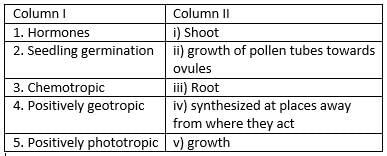UPSC Exam > UPSC Tests > Test: Chemical Coordination In Plants - UPSC MCQ
Test: Chemical Coordination In Plants - UPSC MCQ
Test Description
10 Questions MCQ Test - Test: Chemical Coordination In Plants
Test: Chemical Coordination In Plants for UPSC 2024 is part of UPSC preparation. The Test: Chemical Coordination In Plants questions and answers have been prepared
according to the UPSC exam syllabus.The Test: Chemical Coordination In Plants MCQs are made for UPSC 2024 Exam.
Find important definitions, questions, notes, meanings, examples, exercises, MCQs and online tests for Test: Chemical Coordination In Plants below.
Solutions of Test: Chemical Coordination In Plants questions in English are available as part of our course for UPSC & Test: Chemical Coordination In Plants solutions in
Hindi for UPSC course.
Download more important topics, notes, lectures and mock test series for UPSC Exam by signing up for free. Attempt Test: Chemical Coordination In Plants | 10 questions in 10 minutes | Mock test for UPSC preparation | Free important questions MCQ to study for UPSC Exam | Download free PDF with solutions
Test: Chemical Coordination In Plants - Question 1
How do plant cells achieve shape changes necessary for movement?
Detailed Solution for Test: Chemical Coordination In Plants - Question 1
Test: Chemical Coordination In Plants - Question 2
In plants, what is the main mechanism used for communication between cells to convey information about touch?
Detailed Solution for Test: Chemical Coordination In Plants - Question 2
| 1 Crore+ students have signed up on EduRev. Have you? Download the App |
Test: Chemical Coordination In Plants - Question 3
What distinguishes the movement in a sensitive plant from the movement in a seedling?
Detailed Solution for Test: Chemical Coordination In Plants - Question 3
Test: Chemical Coordination In Plants - Question 4
Which plant hormone is synthesized at the shoot tip, aids in cell elongation, and is involved in phototropism?
Detailed Solution for Test: Chemical Coordination In Plants - Question 4
Test: Chemical Coordination In Plants - Question 5
What type of movement in plants is related to growth and can be either towards or away from stimuli?
Detailed Solution for Test: Chemical Coordination In Plants - Question 5
Test: Chemical Coordination In Plants - Question 6
What type of plant movement is characterized by an immediate response to the stimulus and involves the use of electrical-chemical means for cell-to-cell communication?
Detailed Solution for Test: Chemical Coordination In Plants - Question 6
Test: Chemical Coordination In Plants - Question 7
What is the primary function of Gibberellin in plants?
Detailed Solution for Test: Chemical Coordination In Plants - Question 7
Test: Chemical Coordination In Plants - Question 8
What type of movement in plants involves growth responses towards or away from gravity?
Detailed Solution for Test: Chemical Coordination In Plants - Question 8
Detailed Solution for Test: Chemical Coordination In Plants - Question 9
Detailed Solution for Test: Chemical Coordination In Plants - Question 10
Information about Test: Chemical Coordination In Plants Page
In this test you can find the Exam questions for Test: Chemical Coordination In Plants solved & explained in the simplest way possible.
Besides giving Questions and answers for Test: Chemical Coordination In Plants, EduRev gives you an ample number of Online tests for practice
Download as PDF


















